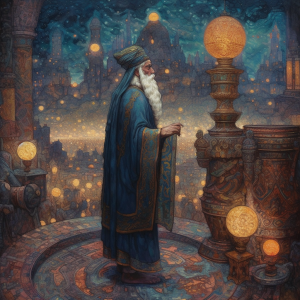Coming of Salmakhamer
The Coming of the Prophet Salmakhamer marks the beginning of the Isxinthion Calendar. The prophet Salmakhamer is thought to be from ancient Kalama or Lucacia and is claimed by as many lands in between those regions. Historians generally accept Kalama as the land of his nativity and the anniversary of his birth is celebrated with much enthusiasm by both Arathracians and Tassans to this day. Salmakhamer is considered a 'holy man' or saint of the Isxinthion Gods. While the Isxinthion Gods had been worshiped for well over fifteen thousand years before his time, Salmakhamer brought a message of reformation and return to their worship as a cure for plagues and famines and the rejuvenation of human tribes. He visited many lands throughout the Pallathantic with his message and Elántuventh claims the site of his burial.
Salmakhamer also taught the Isxinthion Calendar which begins the year on Summer Solstice. Prior to this time many tribes and cultures outside of Kalama began the year on Spring Equinox.
Celebrations for Coming of Salmakhamer
Festivals are held throughout the Pallathantic to commemorate the Coming of Salmakhamer.
Festival of Salmakhumratta
Salmakhumratta is celebrated in the Tassan Highlands and elsewhere in Corundy and Lucacia in late spring. An elder is chosen to visit the neighboring village and so forth, so that it appears a stranger has come. The old man dresses in white robes and and a golden cap in Corundy. In Lucacia, he wears light blue robes and a red cap. The man enters on foot and has a great beard. It is considered a blessing to the visited village for him to arrive early in the morning. When he enters, a shout is given through the village and a common greeting is said to welcome him. Each village prides itself on the uniqueness of their greeting, though they often are had along these lines, "Behold the Messenger of the Gods," "Welcome Bearer of Gods!", "Blessed Gods!", or "The prophet of the Gods!" In some places, the villagers will shake wooden rattles to drive away evil spirits to ensure the man's safe arrival and passage.
If the old man representing Salmakhamer passes during the late afternoon or evening, he is offered food from the dinner table. For this purpose, the doors of most households are propped open, so that if Salmakhamer passes, the householders can offer him a small gift of food. Salmakhamer will usually accept the food in bag or an attendant with him will take the food in his behalf.
Festival of Jaffs
In High Pytharnia, the Festival of Jaffs celebrates the coming of the old man of the gods in late autumn. The man has a great white beard and passes through the village in the afternoon or early evening. He wears white robes and a long red cap. He speaks the words, "Bright and holy, let them enter! Bright and holy, let them enter!", meaning allow the entrance of the true gods of Isxinthios into the village. In High Pytharnian lore, it is believed that Salmakhamer returned from a pilgrimage to the mountain tops, typically the Jaggudorns, and is coming to bless the village. Some villages will have a procession with village-men bearing an image of the town's patron Isxinthion God, following the man portraying Salmakhamer. The elderly will ring bells when they see Salmakhamer approaching. After he passes, people will say to the elderly ringing bells, "Behold the holy and bright!," to which the elderly person will reply, "Honor the gods." After a few such exchanges, the elderly person will stop ringing the bell.
See Also
| This article is a stub. It requires further development by the creator. |
